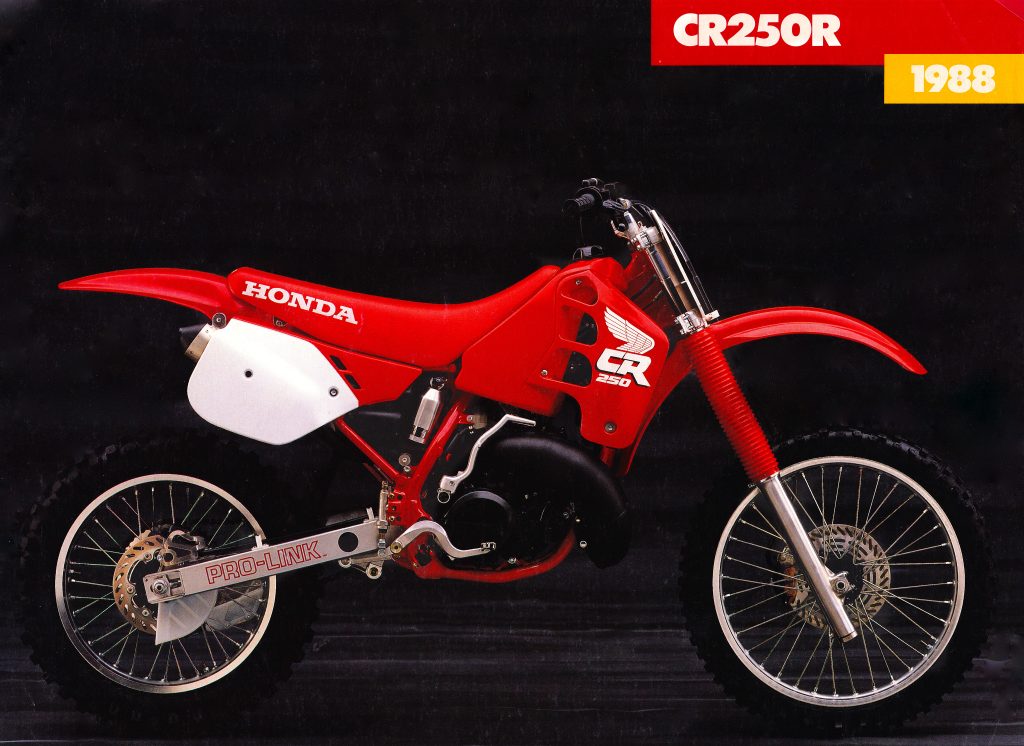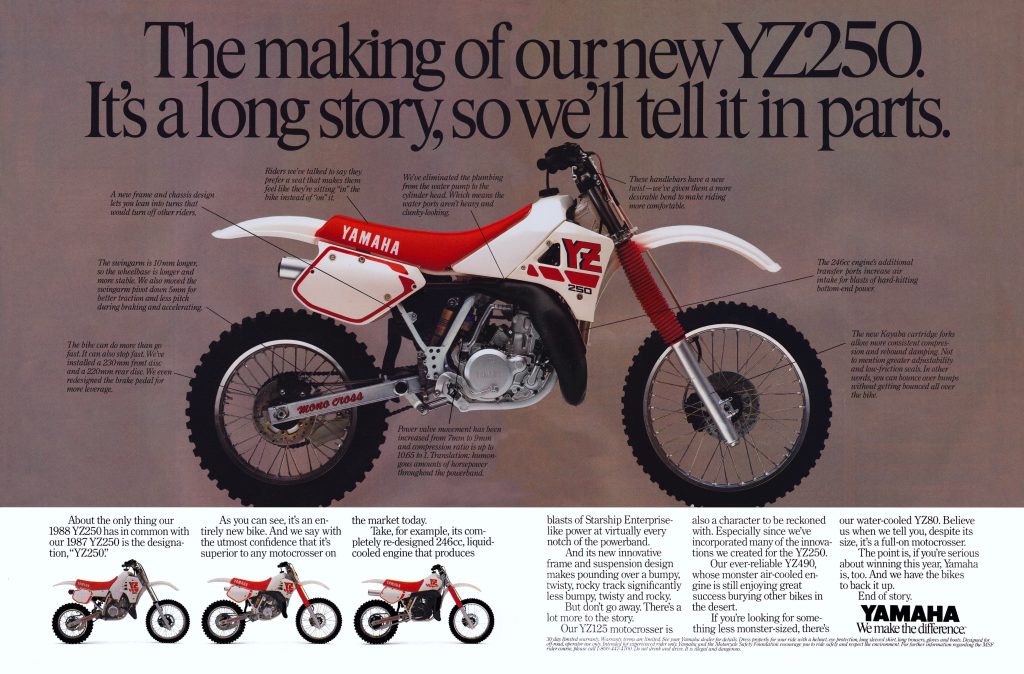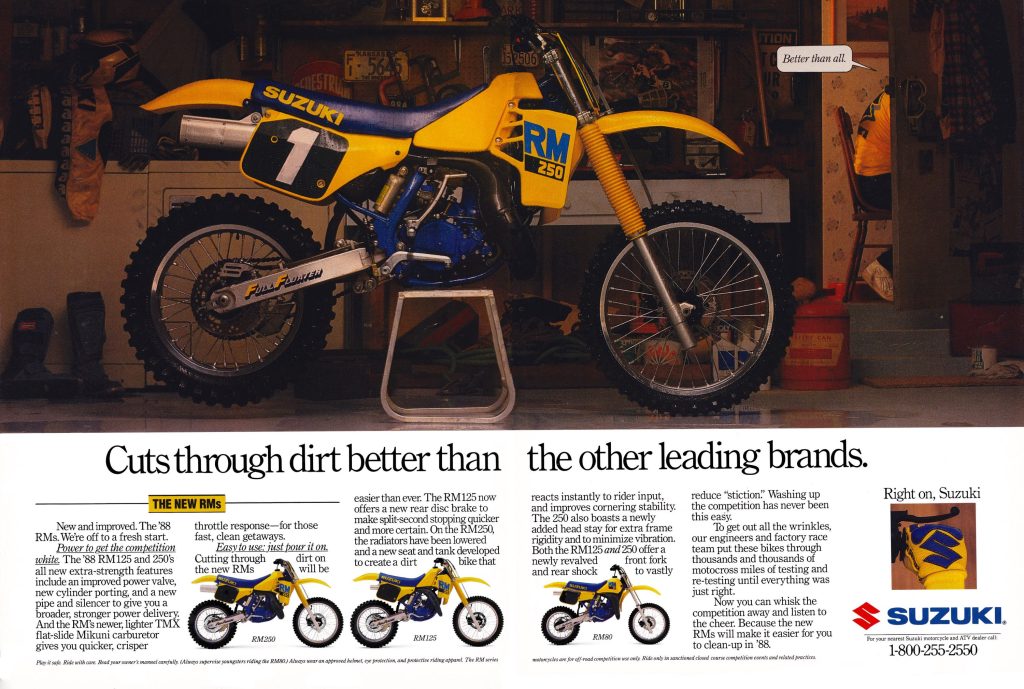
For this edition of Classic Ink, we are going to take a look back at the 250 motocross lineup of 1988.
The 1988 season was an exciting one for 250 motocross enthusiasts. Three of the Big Four Japanese machines were all new, with the fourth from Suzuki featuring major revisions in appearance and performance. Both Honda and Yamaha offered sleek new bodywork for their 250s with elements taken directly from their exotic works machines. Kawasaki went the opposite direction with a big and chunky feel that contrasted notably from the slim and trim ’87 KX. None of the machines proved omnipotent, with all of them suffering minor or major missteps that prevented any one 250 from being the unanimous choice in 1988. Most of these shortcomings were easily addressed with some aftermarket help with all of the machines offering a solid platform from which to craft a winner.
 1988 Honda CR250R: Of all the all-new machines introduced in 1988, it is hard to argue that the most anticipated was not Honda’s CR250R. In 1987, the CR250R was the unanimous choice for the best 250 in the land and the exotic new ’88 looked to continue that win streak with sexy new “low boy” bodywork and a luscious coat of Ferrari red paint. Unfortunately, changes made to the motor and suspension for 1988 quickly sapped away the enthusiasm for the CR’s lusty looks. The CR’s magic cartridge forks and previously unparalleled HPP motor pulled major endos as the red machine transitioned from the most anticipated to the most disappointing machine of 1988.
1988 Honda CR250R: Of all the all-new machines introduced in 1988, it is hard to argue that the most anticipated was not Honda’s CR250R. In 1987, the CR250R was the unanimous choice for the best 250 in the land and the exotic new ’88 looked to continue that win streak with sexy new “low boy” bodywork and a luscious coat of Ferrari red paint. Unfortunately, changes made to the motor and suspension for 1988 quickly sapped away the enthusiasm for the CR’s lusty looks. The CR’s magic cartridge forks and previously unparalleled HPP motor pulled major endos as the red machine transitioned from the most anticipated to the most disappointing machine of 1988.
 The second machine to make a major splash in 1988 was Yamaha’s all-new YZ250. Redesigned in 1986, the YZ received a serious upgrade in 1988 with an all-new styling cribbed from Yamaha’s full-works YZM500. In addition to the new look, Yamaha’s engineers also addressed the previous model’s most significant weakness by round-filing the grim Variable Damping forks of 1987 in favor of Kayaba’s latest cartridge fork design. This alone transformed the YZ from a backmarker to a contender with the new dampers providing a quantum leap forward in comfort and control. Motor changes for 1988 were less dramatic but many people felt the YZM-inspired Yamaha offered the best overall 250 package of 1988.
The second machine to make a major splash in 1988 was Yamaha’s all-new YZ250. Redesigned in 1986, the YZ received a serious upgrade in 1988 with an all-new styling cribbed from Yamaha’s full-works YZM500. In addition to the new look, Yamaha’s engineers also addressed the previous model’s most significant weakness by round-filing the grim Variable Damping forks of 1987 in favor of Kayaba’s latest cartridge fork design. This alone transformed the YZ from a backmarker to a contender with the new dampers providing a quantum leap forward in comfort and control. Motor changes for 1988 were less dramatic but many people felt the YZM-inspired Yamaha offered the best overall 250 package of 1988.
 This ad for the all-new 1988 KX250 touts Jeff Ward’s Supercross championship victory in 1987 but the two machines could not have been more different. In 1987, the KX250 was a slim and sleek tractor of a machine with razor-thin ergonomics, disappointing suspension, and the most grunt in the class. The KX blasted out of every turn with instant power but the chassis and suspension were far from the best in the class. For 1988, Kawasaki scrapped every component of the 1987 machine in favor of an all-new design and upped the technology in the motor and suspension. Like the Yamaha, the new Kawasaki finally copied Honda by going to a sophisticated cartridge damping system for its 43mm Kayaba forks. The motor gained an additional valve in the KIPS system and the frame featured new geometry and stronger construction. Of all the changes made for 1988, however, the most controversial was the KX’s redesigned bodywork. In 1987, the KX had featured the slimmest ergonomics in the class, but for 1988, Kawasaki went plus-sized with a porky layout that made the machine feel more like an Open class machine than a lithe 250. Kawasaki’s reasoning for this was that some riders (notably Kawasaki factory rider Ron Lechien) felt the old bike was too thin and this made it difficult to hold on to in the rough. While tall riders like Lechien may have liked the beefy new dimensions, not everyone else was a fan of the heftier feel. Aside from the big boy bodywork, the KX was a much-improved machine. The new triple-valve KIPS motor was an absolute rocket and Kayaba suspension was much improved. There was still a little mid-stroke harshness to the forks and the handling was rather milk toast, but the Kawasaki was a very competitive machine as long you could come to terms with its 500-class feel.
This ad for the all-new 1988 KX250 touts Jeff Ward’s Supercross championship victory in 1987 but the two machines could not have been more different. In 1987, the KX250 was a slim and sleek tractor of a machine with razor-thin ergonomics, disappointing suspension, and the most grunt in the class. The KX blasted out of every turn with instant power but the chassis and suspension were far from the best in the class. For 1988, Kawasaki scrapped every component of the 1987 machine in favor of an all-new design and upped the technology in the motor and suspension. Like the Yamaha, the new Kawasaki finally copied Honda by going to a sophisticated cartridge damping system for its 43mm Kayaba forks. The motor gained an additional valve in the KIPS system and the frame featured new geometry and stronger construction. Of all the changes made for 1988, however, the most controversial was the KX’s redesigned bodywork. In 1987, the KX had featured the slimmest ergonomics in the class, but for 1988, Kawasaki went plus-sized with a porky layout that made the machine feel more like an Open class machine than a lithe 250. Kawasaki’s reasoning for this was that some riders (notably Kawasaki factory rider Ron Lechien) felt the old bike was too thin and this made it difficult to hold on to in the rough. While tall riders like Lechien may have liked the beefy new dimensions, not everyone else was a fan of the heftier feel. Aside from the big boy bodywork, the KX was a much-improved machine. The new triple-valve KIPS motor was an absolute rocket and Kayaba suspension was much improved. There was still a little mid-stroke harshness to the forks and the handling was rather milk toast, but the Kawasaki was a very competitive machine as long you could come to terms with its 500-class feel.
 Suzuki fell on some really hard times in the mid-eighties with a run of sub-par machines that failed to live up to the excellent reputation they had established in the late seventies. Even the RM’s once impeccable reputation for suspension excellence came into question with the retirement of the original Full Floater design in 1986. That same year, Suzuki hired motocross legend Bob Hannah away from Honda and he set about righting team Yellow Magic’s trouble motocross program. In 1987, the introduction of a more conventional bottom-link rear suspension system and a redesigned motor brought the RM250 back from the brink of irrelevance, but its oddball ergonomics and quirky construction continued to limit its appeal. In 1988, Suzuki updated the ergonomics with a new tank that lowered the radiators a full two inches and slimed up the pilot’s compartment. Suzuki also cured the stalling problems of 1987 with a new Mikuni “Slingshot” carburetor that improved response and finally added an idle circuit. These changes and some additional motor tweaks added up to a much-improved machine. The RM’s motor and suspension were excellent and the new tank gave the bike a more modern feel. The rest of the bodywork remained slightly cobby, but overall ergonomics were no longer a handicap and many felt the revamped RM250 was the best overall machine available in 1988.
Suzuki fell on some really hard times in the mid-eighties with a run of sub-par machines that failed to live up to the excellent reputation they had established in the late seventies. Even the RM’s once impeccable reputation for suspension excellence came into question with the retirement of the original Full Floater design in 1986. That same year, Suzuki hired motocross legend Bob Hannah away from Honda and he set about righting team Yellow Magic’s trouble motocross program. In 1987, the introduction of a more conventional bottom-link rear suspension system and a redesigned motor brought the RM250 back from the brink of irrelevance, but its oddball ergonomics and quirky construction continued to limit its appeal. In 1988, Suzuki updated the ergonomics with a new tank that lowered the radiators a full two inches and slimed up the pilot’s compartment. Suzuki also cured the stalling problems of 1987 with a new Mikuni “Slingshot” carburetor that improved response and finally added an idle circuit. These changes and some additional motor tweaks added up to a much-improved machine. The RM’s motor and suspension were excellent and the new tank gave the bike a more modern feel. The rest of the bodywork remained slightly cobby, but overall ergonomics were no longer a handicap and many felt the revamped RM250 was the best overall machine available in 1988.




